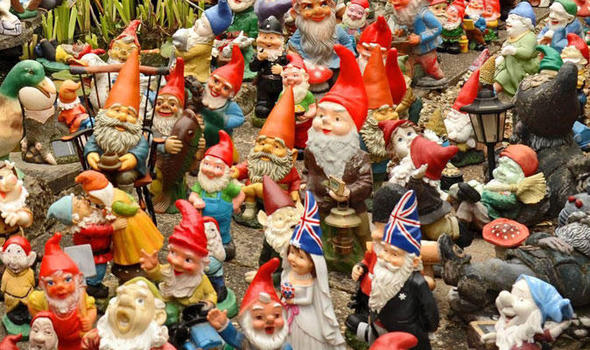“We’ve all heard of the glass ceiling and how hard it is to smash it. But what about the earth ceiling?”

After a century of rejection a great inequality is about to be rectified: garden gnomes are to be allowed into this year’s Chelsea Flower Show. In the 100 years since it began the pointy-capped figurines have always been denied entry to the world’s most prestigious garden show. Gnomes may be much-loved by suburban gardeners throughout the land – and indeed other lands – but the Royal Horticultural Society claims they distract people from looking at plants. That at least is the official line. Many believe the real reason for the ban is plain snobbery. Gnomes are considered too “below stairs” for Chelsea. Too tacky.
But in Chelsea’s 100th anniversary year show the RHS has decided not only to allow gnomes in but to grant them VIP status. There will be “best-dressed” gnomes decorated by celebrity fans (Dolly Parton is known to be one while the late George Harrison was photographed in the Seventies with his favourite gnome peeping out of his shirt) and 150 gnomes will be lined up on parade for inspection by the Queen. (Somehow you just know that Her Majesty will approve.) After all those years of slights and snobbery, gnomes are getting a little respect.
And about time too, for the history of the garden gnome is far older than the Chelsea Flower Show. Garden gnomes predate the RHS itself (founded in 1805) by at least a couple of centuries and have in their time been regarded variously as lucky talismans, symbols of class warfare and even instruments of political subversion.
They first appear during the Renaissance in the writings of Swiss alchemist Paracelsus who described diminutive figures two spans in height who did not like to mix with humans.
The word gnome derives from the Latin gnomus which itself comes from the Greek genomosmeaning “earth-dweller”. According to Paracelsus, gnomes could move through solid earth as easily as humans move through air. The word first appears in English in the early 18th century referring to reincarnations of prudish women in Alexander Pope’s poem The Rape Of The Lock.
For all its English associations the garden gnome is originally German. Though landscape artists in Renaissance Italy used gnome-like statues in gardens and gnome figures made of porcelain or wood were popular as house ornaments in the 18th century, Baehr and Maresch of Dresden are credited with stocking the first ceramic examples in 1841. From the German provinces of Saxony and Thuringia garden gnomes soon spread across Germany to France and then to Britain.
I n European folklore gnomes are benevolent creatures who come out at night to help humans in secret with their chores in the home or fields. The first ceramic figures were often modelled on characters from local myths but were soon credited with supernatural powers as protectors of barns and garden stores.
The first gnomes crossed the Channel in 1847 with Sir Charles Isham, 10th baronet, who wanted something colourful for the rock garden at Lamport Hall, his Northamptonshire home, and bought 21 terracotta figures from German manufacturer Philip Griebel. One of the original batch – nicknamed Lampy – can still be seen at the Isham estate and is valued at £2million.
The Griebel company makes gnomes to this day. The only time production dipped was during the Second World War and for a few years afterwards when the communist regime in what became the German Democratic Republic (East Germany) were convinced the gnomes could be used for smuggling. Eventually their fears were assuaged and garden gnomes went on to become East Germany’s leading export.
Britain’s golden age for gnomes was in the Thirties when the expansion of the suburbs led to more people having gardens which of course really meant more working-class people. Perhaps the most notable British manufacturer was Tom Major-Ball, the father of our last working-class PM John Major.
But that ubiquity also spelled the beginning of the end for gnomes. Originally fashioned from runny clay poured into moulds, baked in a kiln and then hand-painted, the introduction of cheap plastic models robbed the garden gnome of any vestige of artistic merit it might have once possessed. And it was not just the RHS that took against them because gnomes became the vilified target for what some would call pranksters and what others might label vandals.
In the Seventies a London journalist snatched dozens of gnomes from gardens and hanged them from nooses in his bedroom. In 2008 a 53-year-old man in Brittany was accused of stealing more than 170 garden gnomes. Gnomes have vanished from gardens only to be next seen when the owner receives a postcard depicting the statue in some foreign location or other. (In the French film Amelie, that was what persuaded her extremely uptight father to branch out and go travelling.)
In the US a group who call themselves the Gnome Liberation Front campaign to “stop oppressive gardening” and free gnomes from “enslavement” in flower beds, lawns, garden centres.
In previous years at Chelsea protesters dressed as gnomes have demonstrated outside the gates, demanding equal entry rights for what you might call our own version of the Terracotta Army. All harmless fun one might say which does nobody (gnome-body?) any harm and the RHS is keen to join in. “It is important for people to realise we have got a sense of humour and don’t take ourselves too seriously,” says RHS director-general Sue Biggs.
However victory for gnomes and those who love them will be short-lived. In fact it will last just for the four days of this year’s flower show. Next year gnomes are to be banished back into garden apartheid.
In which case stand by for the battle of gnome-man’s land.
I looooooooooooove flowers!!!!!!!!!!!!!
XOXO Tabitha the Gnome
